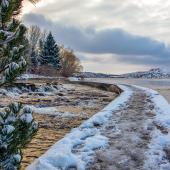Fishing Paradise
All you need to know before you hit the rivers.
Bozeman, with its proximity to so much legendary water, is Big Sky Country’s epicenter for adventurous anglers—especially with rivers boasting names like the Madison, Missouri, and Big Hole all within a short drive. But there are rivers, and then there is the Yellowstone. From its headwaters southeast of Yellowstone National Park, “the ‘Stone” flows over 670 miles, through some of the most spectacular and wild terrain this country has to offer. Celebrated by watermen of all types, the Yellowstone River remains the longest free-flowing, undammed river in the contiguous United States. Yet it is perhaps best known as one of the most pristine and wild trout rivers in the country. The 103 miles of water from the gateway community of Gardiner to Big Timber represent an aquatic Shangri-la for float and wade fishermen alike.
Access
The nearly 60 miles of water between Gardiner and Livingston offer some of the most breathtaking vistas of any river on the continent. The turbulent and hurried waters from McConnell Landing to Joe Brown provide some of the most reliable dry fly fishing on the entire river, with ample access for both the wade and boat angler and views of the Gallatin Mountains, with their highest point, Electric Peak, looming above. The upper river is best left to the competent oarsmen or women and hardy wade anglers, but it provides some of the finest top-water pocket fishing on the entire Yellowstone.
With the Absaroka Mountains towering above, varied water types, and an abundance of trout, the Paradise Valley section of the river offers over 40 miles of blue-ribbon trout fishing and stunning views. Between the Carbella Fishing Access and Carter’s Bridge on the fringe of Livingston, official Montana FWP sites offer easy access every 5-10 miles.
Flows
As a freestone with its headwaters and tributaries coming from the high-elevation Yellowstone Plateau, the Yellowstone River fluctuates dramatically from season to season—from volatile and turbulent water during spring runoff to a more calm and forgiving river in autumn. In April at Corwin Springs, the river typically hovers around 1,800 cfs, while the median flows over the last decade for the month of June jump to over 10,900. Big-water years may see 27,000 cfs pumping down river. These volumes taper to a very fishable average of 6,000 cfs in July, 2,600 cfs in August, and then level out around 1,500 cfs in September and October.
When to Go
The summer months of July and August constitute the glory season on the Yellowstone. Fishing is fruitful from dawn to dusk. While the armada of guide boats typically work banker hours—on the water around 9 and off by 5—early mornings and twilight provide prolific hatches and fishing bliss. In the spring and fall, the window is shorter, with the magic hours typically between 1-4pm, when the water temperatures rise and the metabolic activity of our finned friends ramp up.
For hatches, the first one worthy of a cult-like following on the ‘Stone each year—the infamous Mother’s Day Caddis hatch—is a total crapshoot. The #14 moth-like caddis typically begin emerging around the first week of May, which often corresponds with sketchy spring weather (raging winds, sleet, hail, and even snow flurries) and the arrival of spring runoff, with its muddied waters. Taking place in late July, the golden stonefly hatch coincides with our highly prolific caddis and mayfly hatches, which abound through most of July and August. And just as the aquatic hatches begin to fade, around mid-August, the real magic begins, when the terrestrials (hoppers, crickets, ants, and beetles) emerge from the riverbanks, allowing for some of the most spectacular and explosive dry-fly fishing in the west.
Fish
Native Yellowstone cutthroats and mountain whitefish (remember to respect Senor Blanco!) abound on the upper river, between Gardiner and Yankee Jim Canyon, where you’ll be rewarded by the slow, deliberate takes of the cutthroat while encountering strong numbers of rainbow trout as well. Though the brown trout numbers aren’t as abundant up top as they are downriver, these Yellowstone River “runners” work their way up the Gardiner River each fall to spawn, proving they are indeed present, even if not easy to catch!
Row vs. Wade
While the Yellowstone is known for its flotillas of drift boats, thanks in part to Montana’s progressive 1985 Stream Access law, the Gardiner to Livingston stretch provides more than ample opportunity for wade fishing. Official and unofficial upper-river access points between the town of Gardiner and Yankee Jim Canyon—Joe Brown, Corwin Bridge, La Duke Hot Springs, and McConnell Landing—provide consistent structure and riffles for wade anglers.
Regulations
The Yellowstone is open all year long with pretty lenient rules. If you hook up with a cuttie, make sure to put it back. Check the FWP website for more regulations.
Hot Spots
Two of the most celebrated stretches to float are between Carbella and Emigrant—made easier by the new FWP access site at Point of Rocks on river left—and the celebrated “Bird Float” from Grey Owl to Mallard’s Rest where the parking lots on weekends often resemble an MSU tailgate party.
Getting There
Head east on I-90 for a scenic 25-mile drive over Bozeman Pass and into the old railroad town of Livingston, Montana. Take the Gardiner exit (number 333) and head south. The 51-mile drive to Yellowstone National Park follows the course of the river. Just 20 miles south of Livingston, in the sleepy saloon town of Emigrant, one will find Angler’s West Fly Shop—whose owner, Matson Rogers, is one of the all-time good guys in the business, creating one of the most friendly and unique fly-shop experiences in the northern Rockies.
Michael Leach has fished the Greater Yellowstone for over two decades, and worked as a fly fishing guide and river educator on the Yellowstone since 2005.










